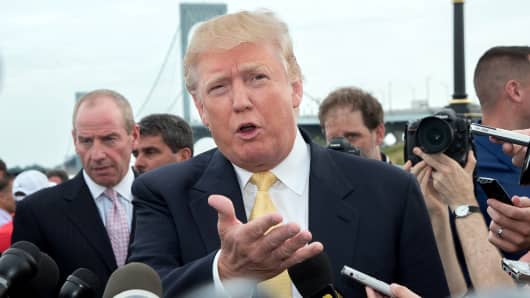Donald Trump's presidential campaign has been scoffed at, but his recent rise to the top of the polls has made him, for the time being, the center of the Republican race. What is odd is that, while Trump could be seen as running a very modern campaign, one based on personal celebrity rather than political contacts, he actually is doing the opposite: Trump is the 2016 throwback candidate. And this very factor may be his undoing.
More than any other candidate, Trump's race is based on getting significant media attention. In recent years, political campaigns have shifted from free press opportunities to focusing on bypassing the media's distribution channels and trying to reach out to voters directly or through social media. Witness one of Trump's possible competitors, New Jersey Governor Chris Christie, who can be seen as the first YouTube candidate. Christie's notoriety is based on his frequent public arguments with opponents, clips of which would get widely shared by supporters through social media. The same new-technology phenomena helped put Barack Obama in the White House, as he used social media such as Facebook, and text messaging to organize his supporters and crucially, to tap into a large base for fundraising. Now, all candidates are extremely focused on the online and mobile world. Not Trump, though.
While his criticisms go viral and he has a popular Twitter account, Trump is not using social media as his primary method of outreach. Instead, he is the candidate most likely to be in front of the cameras and trying to get his face and comments on traditional media outlets, specifically TV, radio and newspaper. A recent Washington Post article by Political Science Professor John Sides notes that Trump has gotten the most media coverage on his campaign of any Republican presidential candidate – 20 to 30 percent of the field since his announcement.
Read More Christie thumps ol' pal Trump
As Trump's poll numbers show, this approach still has significant value, but it has its downside. Trump has much less direct access to his potential pool of supporters. The other candidates are focused on building lists and controlling their viral output. Trump does not appear to be focused on doing that – a process that takes an outlay of money that we haven't seen Trump make.
This use of the traditional media highlights another more serious challenge to any hope of a Trump candidacy. Trump has not been able to convert his poll numbers into the figure that counts before the voting starts in January – fundraising. Fundraising shows that your support is not paper-thin — people have actually dipped into their pockets to try and put you in office. And Trump is simply not raising funds. His campaign treasury seems to be based on his own shifting net worth, which he recently claimed was $10 billion.
In his campaign-finance statements, Trump has exhibited a noted inability to raise funds from either traditional donors or newer online supporters. The fundraising reports from other candidates that came out earlier this month show a broad range of numbers — from Hillary Clinton's $46.7 million to Jeb Bush's $11.4 million all the way down to George Pataki's $256,000. Additionally, many of these candidates also have outside PACs raising tens of millions of dollars tied closely to their campaign. But Trump really stands out here — he's dead last. Outside of a $1.2 million loan, Trump raised only $90,000 this term.
Read MoreOp-ed: Why you should fear Donald Trump
Trump's is apparently basing his run on the idea that he can self-finance his campaign. His lifestyle and his repeated touting of his wealth may turn off potential supporters from actually donating to his campaign. Worse still is that fact that the record of self-funders is notoriously poor. There are a few successful examples, like former three-term New York City Mayor Michael Bloomberg, who is much wealthier than Trump, Florida Governor Rick Scott and Illinois Governor Bruce Rauner.
There are only handful of self-funders above the $10 million range who have had any success. And frequently, the party helps clear the field for the more successful ones of these candidates. A look at some of the noteworthy flameouts sees an astonishing amount of money tossed into the self-funder's campaigns. Trump's former business partner Linda McMahon spent an estimated $97 million dollars to get 43 percent of the Connecticut vote in two failed runs for the U.S. senate. Meg Whitman spent $144 million running for governor of California, where she won less than 41 percent of the vote. All of these totals are for state runs. A national campaign costs an exponentially larger amount.
Read MoreOp-ed: Why I'm voting for Hillary
The self-funding campaign is fraught with trouble, and so far, as his somewhat paltry $1.2 million personal outlay shows, Trump may be very hesitant to actually spend the type of money others have coughed up to win office.
Trump's performance so far shows the potential value of traditional media and a throwback candidacy. But he is also putting a spotlight in the downside. Trump, a man who is running as the businessman candidate, ignores one of the basic saying of the business world at his peril – for in elections, cash is king.
Commentary by Joshua Spivak, a senior fellow at the Hugh L. Carey Institute for Government Reform at Wagner College in New York. He blogs at The Recall Elections Blog. Follow him on Twitter @recallelections.


